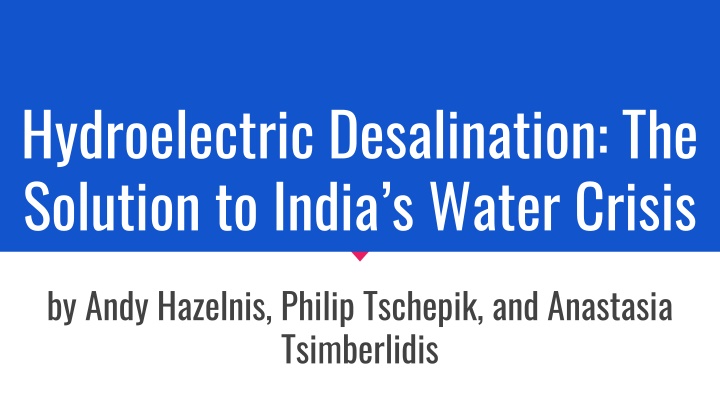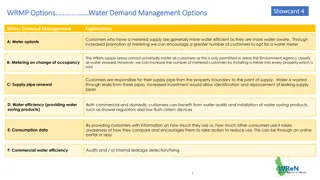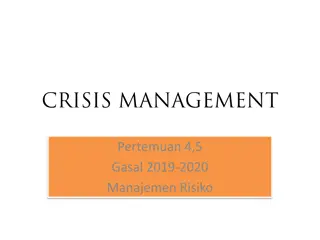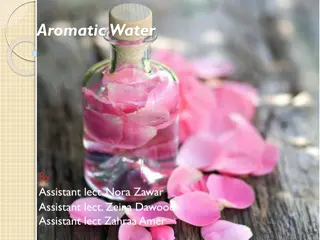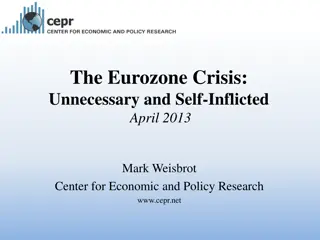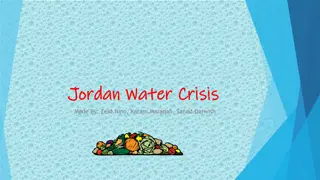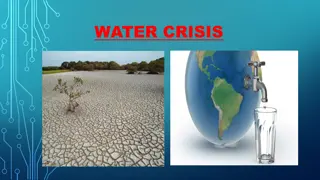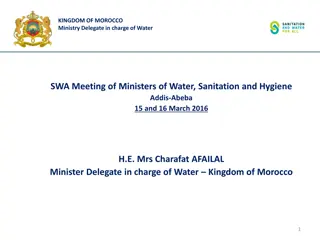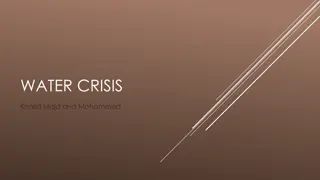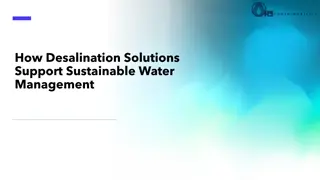Hydroelectric Desalination: A Solution to India's Water Crisis
This presentation addresses the pressing water crisis in India, proposing the implementation of hydroelectric desalination as a viable solution. It explores the global water crisis, financial details, impact on India, implications of desalination, agricultural byproducts, challenges, and potential concerns related to this innovative approach. The visuals and data provide insight into the significance and potential benefits of hydroelectric desalination for addressing water scarcity in India.
Uploaded on Mar 01, 2025 | 0 Views
Download Presentation

Please find below an Image/Link to download the presentation.
The content on the website is provided AS IS for your information and personal use only. It may not be sold, licensed, or shared on other websites without obtaining consent from the author.If you encounter any issues during the download, it is possible that the publisher has removed the file from their server.
You are allowed to download the files provided on this website for personal or commercial use, subject to the condition that they are used lawfully. All files are the property of their respective owners.
The content on the website is provided AS IS for your information and personal use only. It may not be sold, licensed, or shared on other websites without obtaining consent from the author.
E N D
Presentation Transcript
Hydroelectric Desalination: The Solution to India s Water Crisis by Andy Hazelnis, Philip Tschepik, and Anastasia Tsimberlidis
The Global Water Crisis: Spotlight India 1B people lack access to drinking water Water-related diseases - 21% Lack of Traditional Sanitation - 33% of population 1.6 billion by 2050 Long-term availability of replenishable water resources
Financial Details Estimated cost to build $500-650M Fully operational in three years Potable Water Production capacity 624,000 m3/day Electricity produced 9.2 million kWh
Implications of Desalination in India Reliable water supply source Easy to transport Monsoons insufficient crops or overproduction hard to conserve Desertification - 25% Land Degradation - 32%
Byproducts of Desalination and Agriculture Brine as a byproduct of Desalination Wheat as a cereal product of India NaCl Fertilization of Wheat Increases defense mechanisms in plants to survive stress factors and reduce disease incidence. o Sodium as a substitute for potassium o Chloride strengthens root/soil relations o
Potential Concerns World Bank Country Frontier: India Overall Distance to Frontier Score (1-100) Rank (1-189) Environmental Challenges 142 54 Ease of Doing Business 137 63.1 Getting Electricity Political Challenges 36 65 Getting Credit 186 25.1 Enforcing Contracts
Appendix Power = (10 feet) x (1271.33 cubic feet per second) x (0.98) / 11.8 = 1055.85 kilowatts Electric Energy = ( 1055.85 kilowatts) x (24 hours per day) x (365 days per year) = 9,249,246 kilowatt hours People Served = (9,249,246 kilowatts-hours) / (648 kilowatt-hours per person) = 14,274 people. Gallon = .0038m3
